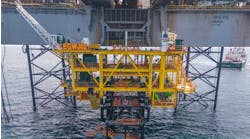Marketing of fixed platforms expanding to fill needs
Bill Riles, Myron Van Kirk
Van Kirk & Riles Interests
The re-utilization of existing offshore platforms for new development projects provides operators significant flexibility in project development considerations. The re-utilization option typically has several benefits:
- More cost effective development than provided by comparable new construction
- An accelerated project development schedule providing earlier production and enhanced cash flow.
- Additional investment recovery from existing properties by reducing salvage costs with the residual value of platforms and equipment.
As the industry segment continues to expand, the demand for re-usable structures and production facility equipment will increase. A significant need now exists for professional marketing and procurement services providing all operators access to knowledge of existing properties and an opportunity to participate in this growing segment of the industry. Further, those providing these services may also assist operators in the implementation and execution of re-utilization projects.
Since the inception of the offshore industry in the United States, more than 4,000 structures have been installed in the Gulf of Mexico. As a condition of state and federal lease agreements, each concession, upon suspension of production, must be restored to original condition. Thus, a significant industry exists in the removal of offshore platforms and the associated production facilities. According to the Minerals Management Service of the Department of the Interior (MMS), more than 1 ,000 structures have been permitted for removal to date, with 134 scheduled in 1996 alone. Though specific records are not readily available, MMS sources also estimate more than one-hundred existing platforms have been reinstalled to date. As the number of structures installed throughout t the 1980s approach removal, salvage and re-utilization opportunities will increase.
Not all existing structures are candidates for reuse. Poor condition and/or stringent recertification requirements relegate many older structures to the scrap yard. In some cases, the deck and production equipment may be reusable but the jacket, due to recertification requirements, physical condition, or physical characteristics, may not be usable. Conversely, a jacket may be reusable but the a associated deck, due to poor maintenance or damage, may not be usable. A significant number of recent Gulf of Mexico development projects have used, in whole or in significant part, existing production facilities and structural components. Not only does this practice generally cost less than alternative new facilities; but also, and perhaps more importantly, allows operators to get projects "on-stream" more quickly. Development costs of re-utilization projects have historically averaged approximately 75% of comparable new construction alternatives. Market factors, including supply and demand, have caused comparative percentage to vary as widely as 60% -- 100% with equivalent capital costs of used components at times being advantageous due to early delivery.
Many logistical considerations apply to comparative development schedules between new and re-utilization projects; however, proper planning with a re-utilization project can provide significant acceleration of the project schedule. Considerable flexibility can exist in the salvage data of the existing property. The degree of requisite addition, modification, and/or refurbishment can significantly influence the turnaround schedule of the re-utilization property. Therefore, it is important to match needs between existing structures and new developments as closely as possible to minimize change. In some straightforward direct re-utilizations, properties can be taken directly from one offshore location to another. To expedite re-utilization, the purchase operator must often be willing to compromise and accept operational and equipment variances from company standards. Appreciation of the permitting process and permit requirements will also expedite the re-utilization project. If new construction and material requirements are minimized, current extended material delivery schedules may not affect re-utilization schedules nearly as significantly as with new construction.
With new construction capacity reduced in comparison to the late 1 970s and early 1 980s and with the current development of numerous large, deepwater projects absorbing considerable fabrication yard capacity, the actual construction viability of small to medium size projects is threatened. Yard space, materials, production equipment, and construction services are all in shorter supply. Re-utilization projects requiring limited modification or refurbishment, capable of being executed in smaller to medium-sized fabrication yards or as filler projects in the larger fabrication yards, and not using the larger derrick barges for installation may actually become viable within reasonable schedules when contrasted with new construction alternatives.
Re-utilization of existing properties enables operators to partially reclaim prior investments by recognizing and capitalizing the residual value of offshore properties. With the promotion of re-utilization, offshore assets may ultimately become the renewable resources originally visualized in the development of the offshore industry. Design-enhanced salvage and re-use could finally become common as important factors in the establishment of the future value of properties. Offshore platform reuse within operating companies and between operators will provide the offshore industry an expanding segment in the coming years.
The re-utilization of platforms has achieved credibility and acceptance throughout the industry -- with operators, contractors., and regulatory agencies. The regulatory community has established defined procedures to permit these applications including a specific section on the reuse of platforms in the current edition of API RP 2A "Recommended Practice for Planning, Designing., and Constructing Fixed Offshore Platforms". Extensive experience with re-utilization projects has defined specific focus areas traditionally most significant to the establishment and evaluation of technical., scheduling, and commercial viability of re-utilization -- areas such as jacket joint can materials and thicknesses, deck structure and production facility coatings (including the general condition and the potential presence of lead), production vessels (including general condition and the potential presence of NORM) and the condition of the production equipment piping and controls systems. Significant problems in any of these areas may delay schedules, eliminate cost advantages, or otherwise preclude re-utilization.
As the number of viable offshore production properties available for reuse increase and as the re-utilization practice gains increasing acceptance, the salvage, refurbishment and/or modification, and re-installation of existing offshore structures and production facilities will become a much more significant segment within the offshore industry. In much the same manner as the growth and acceptance pattern of the minimum concept, marginal field structures introduced in the mid-1980's, the now proven, successful, efficient re-utilization practice is moving from the province of the small independents to the arena of large independents and majors. With this increasing re-utilization of existing offshore platforms, there is a need for associated experienced professional services in this segment of the offshore industry.
Comprehensive professional marketing and procurement services are necessary to successfully promote and sustain this relatively new and growing industry segment. Such marketing services of existing properties - comprising both sales representation for owners and/or procurement for operators of new developments - should include:
- Principled, professional operations
- Representational control
- Appreciation of technical, regulatory and commercial factors
- Project management and technical expertise
- Development of a centralized database
- Project development financial services.
Principled, professional operations provide operators the necessary confidence to accomplish objectives, consummate transactions, and execute projects. Confidence - as exemplified in trust, integrity, respect, and competence - is requisite in the success of any business venture.
Representational control of existing properties is critical. Purchasing operators must develop trust and confidence in the credibility and availability of the marketing professional's services and properties. Likewise, selling operators must have confidence in the marketing professionals competence and ability to sell the property. These relationships are formed and greatly enhanced by the marketer's representational control of marketed properties. Control can be established by several means including sales representation agreements (analogous to a listing agreement in the real estate industry), purchase options, or actual purchases of the property. Depending on the representational control mechanism, the compensation structure for marketing and procurement services may be customized to suit individual operators and applications.
Understanding and appreciation of technical, regulatory, and commercial aspect of reutilization projects is paramount to the marketing professional's efforts. Such knowledge allows establishment and representation of the viability of proposed re-utilization project solutions. Associated expense and schedule projections are more valid and reliable for evaluation and comparison with other project options.
Project management and technical expertise possessed by the marketing professional allows provision of supplemental functions including turnkey and professional services, and supervisory execution of design, fabrication, installation, and operations functions. This expertise and experience allows the professional marketing firm to evaluate and establish a proposed re-utilization execution schedule and budget providing operators a basis for comparison with other development alternatives. The experience also allows the provision of supplemental project management services through the ability, if required and necessary, to manage the re-utilization project for the purchasing operator. Therefore, the professional marketer, as the developer of the proposed re-utilization solution to a development project, can participate in the management of the execution and realization of the project.
A comprehensive property and project database will enable the marketing professional to efficiently and optimally serve both selling and purchasing operators by providing access to and knowledge of as many existing properties as possible. The data is obtained and updated with information from operators and through public information from regulatory agencies. The database includes functional, schedule, and commercial parametric definition of both existing properties and new projects. Data provides enhanced matching capabilities between existing properties and new project requirements. The database also includes commercial information allowing development of historical sales and cost information. This data is most valuable to operators and marketing professionals in the establishment of prices and in generalized assistance to operators with evaluations for insurance, bonding, cost allocation replacement, and project requirements.
The marketing professional should have the ability to offer operators, if necessary and as required, the opportunity to obtain project financing and assistance in providing acquisition and development funds.
Copyright 1996 Offshore. All Rights Reserved.


